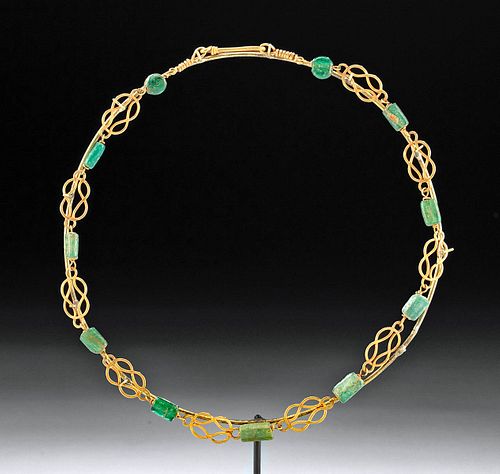Fine Roman Gold Hercules Knot & Glass Bead Necklace
Lot 63
About Seller
Artemis Gallery
686 S Taylor Ave, Ste 106
Louisville, CO 80027
United States
Selling antiquities, ancient and ethnographic art online since 1993, Artemis Gallery specializes in Classical Antiquities (Egyptian, Greek, Roman, Near Eastern), Asian, Pre-Columbian, African / Tribal / Oceanographic art. Our extensive inventory includes pottery, stone, metal, wood, glass and textil...Read more
Categories
Estimate:
$7,000 - $9,000
Absentee vs Live bid
Two ways to bid:
- Leave a max absentee bid and the platform will bid on your behalf up to your maximum bid during the live auction.
- Bid live during the auction and your bids will be submitted real-time to the auctioneer.
Bid Increments
| Price | Bid Increment |
|---|---|
| $0 | $25 |
| $300 | $50 |
| $1,000 | $100 |
| $2,000 | $250 |
| $5,000 | $500 |
| $10,000 | $1,000 |
| $20,000 | $2,500 |
| $50,000 | $5,000 |
| $100,000 | $10,000 |
| $200,000 | $20,000 |
About Auction
By Artemis Gallery
Oct 7, 2021
Set Reminder
2021-10-07 10:00:00
2021-10-07 10:00:00
America/New_York
Bidsquare
Bidsquare : Exceptional Antiquities Ethnographic Fine Art
https://www.bidsquare.com/auctions/artemis-gallery/exceptional-antiquities-ethnographic-fine-art-7537
Museum-worthy examples of Egyptian, Greek, Roman, Etruscan, Near Eastern, Far East / Asian, Pre-Columbian, African / Tribal, Oceanic, Native American, Spanish Colonial, Fossils, Ancient Jewelry, Fine / Visual Arts, so much more! Artemis Gallery info@artemisgallery.com
Museum-worthy examples of Egyptian, Greek, Roman, Etruscan, Near Eastern, Far East / Asian, Pre-Columbian, African / Tribal, Oceanic, Native American, Spanish Colonial, Fossils, Ancient Jewelry, Fine / Visual Arts, so much more! Artemis Gallery info@artemisgallery.com
- Lot Description
Roman, Imperial Period, ca. 2nd to 3rd century CE. A gorgeous necklace of ancient composition comprised of verdant green glass beads and Hercules knot wire beads made from 80.48% gold (equivalent to 18K+). The accessory features 10 ovoid beads in the classic interwoven Hercules (Greek Herakles) knot form with integral suspension looks that alternate with 11 glass beads of translucent and nearly opaque styles. Two discoid glass beads rest beneath the shepherd's hook and loop on the terminals and gradually lengthen to form lozenge-shaped and rectangular forms. Also known as the "love knot," the Hercules knot was a powerful symbol of two souls entwining during traditional marriage ceremonies. This necklace, concurrently, was perhaps a marriage gift to a newlywed couple in ancient Roman times. Size (necklace): 15.5" L (39.4 cm); 6.8" H (17.3 cm) on included custom stand; (Herakles knots): 0.8" L x 0.375" W (2 cm x 1 cm); (largest glass bead): 0.4" L x 0.2" W (1 cm x 0.5 cm); quality of gold: 80.48% (equivalent to 18K+); total weight: 15.2 grams
In the Classical World, the Hercules knot was believed to be the knot form used by Hercules (Greek Herakles) to tie the skin of the Nemean lion around his neck after he slayed the beast, thus fulfilling the first of twelve labors bestowed upon him by King Eurystheus. Given this affiliation with the Greek hero known for his mighty strength and courage, this knot was generally regarded as a protective symbol.
According to the British Museum, "The marriage-knot or knot of Hercules, a strong knot created by two intertwined ropes, originated as a healing charm in ancient Egypt, but is best known for its use in ancient Greece and Rome as a protective amulet, most notably as a wedding symbol. The symbolism of the knot survived well beyond its religious use, and was a common symbol in medieval and Renaissance love tokens." In addition, according to Roman historian Pliny, the Hercules knot was said to possess the power to cure ailments and heal wounds.
Cf. a gold necklace with green emerald beads at The Metropolitan Museum of Art, accession number 20.239
Cf. Christie's, New York "Ancient Jewelry" auction (sale 1313, December 11, 2003, lot 444)
This piece has been searched against the Art Loss Register database and has been cleared. The Art Loss Register maintains the world's largest database of stolen art, collectibles, and antiques.
Provenance: private Santa Fe, New Mexico USA collection; ex-Art for Eternity, New York, New York, USA; ex-Gerhard Hirsch Auction, Munich, Germany (September 2016, lot 1085); ex-German collection, acquired before 2000
All items legal to buy/sell under U.S. Statute covering cultural patrimony Code 2600, CHAPTER 14, and are guaranteed to be as described or your money back.
A Certificate of Authenticity will accompany all winning bids.
PLEASE NOTE: Due to recent increases of shipments being seized by Australian & German customs (even for items with pre-UNESCO provenance), we will no longer ship most antiquities and ancient Chinese art to Australia & Germany. For categories of items that are acceptable to ship to Australia or Germany, please contact us directly or work with your local customs brokerage firm.
Display stands not described as included/custom in the item description are for photography purposes only and will not be included with the item upon shipping.
#167684Wearable as shown. All components are ancient. Slight bending to some gold components, abrasions and small nicks to some glass beads, and light encrustations, otherwise intact and excellent. Wonderful preservation to gold and glass with nice patina throughout.Condition
- Shipping Info
-
All shipping is handled in-house for your convenience. Your invoice from Artemis Gallery will include shipping calculation instructions. If in doubt, please inquire BEFORE bidding for estimated shipping costs for individual items.
-
- Buyer's Premium



 EUR
EUR CAD
CAD AUD
AUD GBP
GBP MXN
MXN HKD
HKD CNY
CNY MYR
MYR SEK
SEK SGD
SGD CHF
CHF THB
THB













